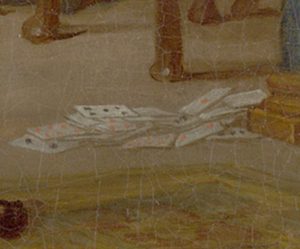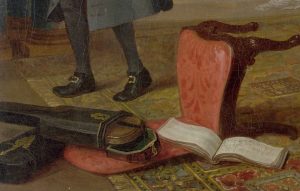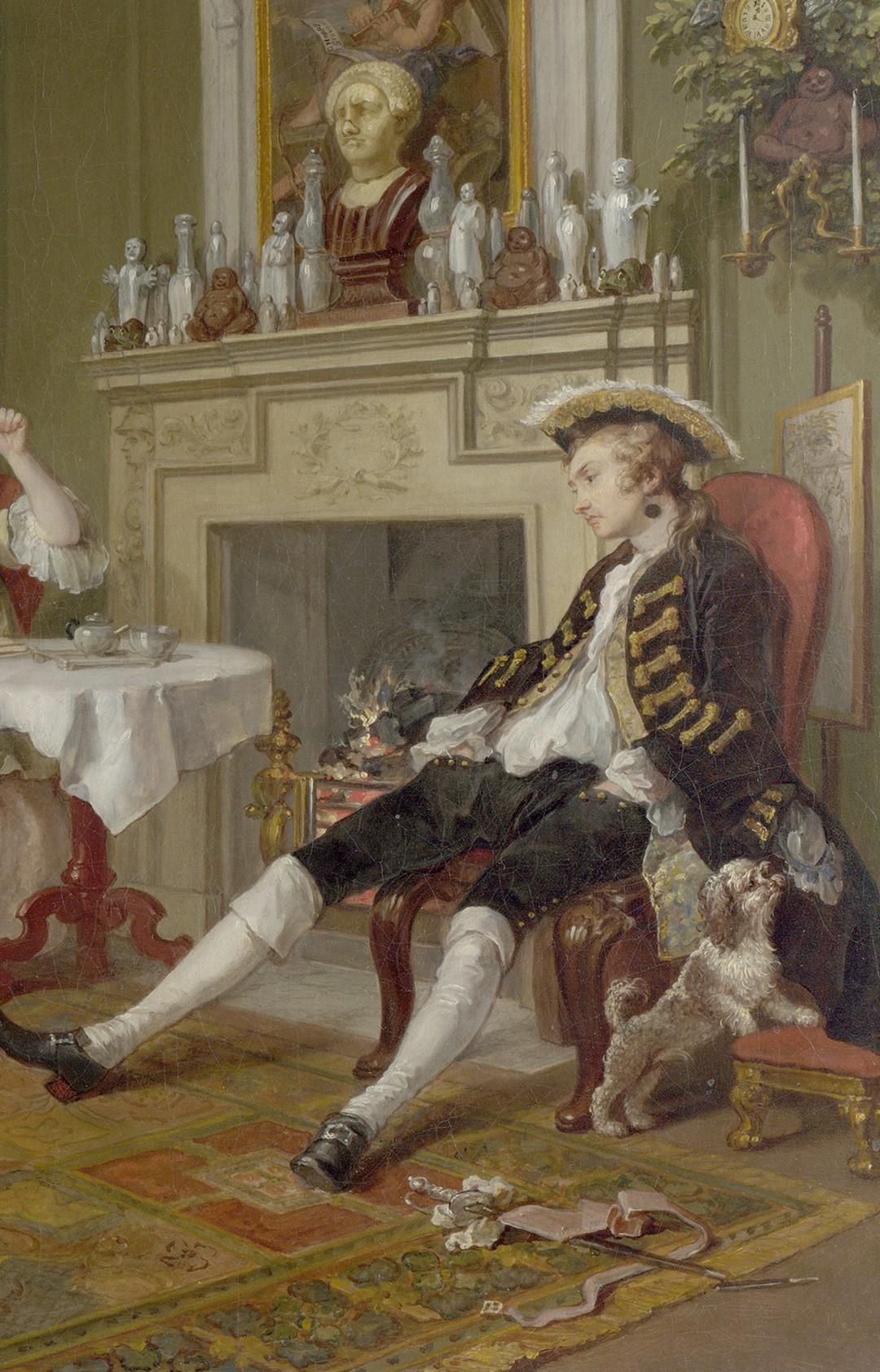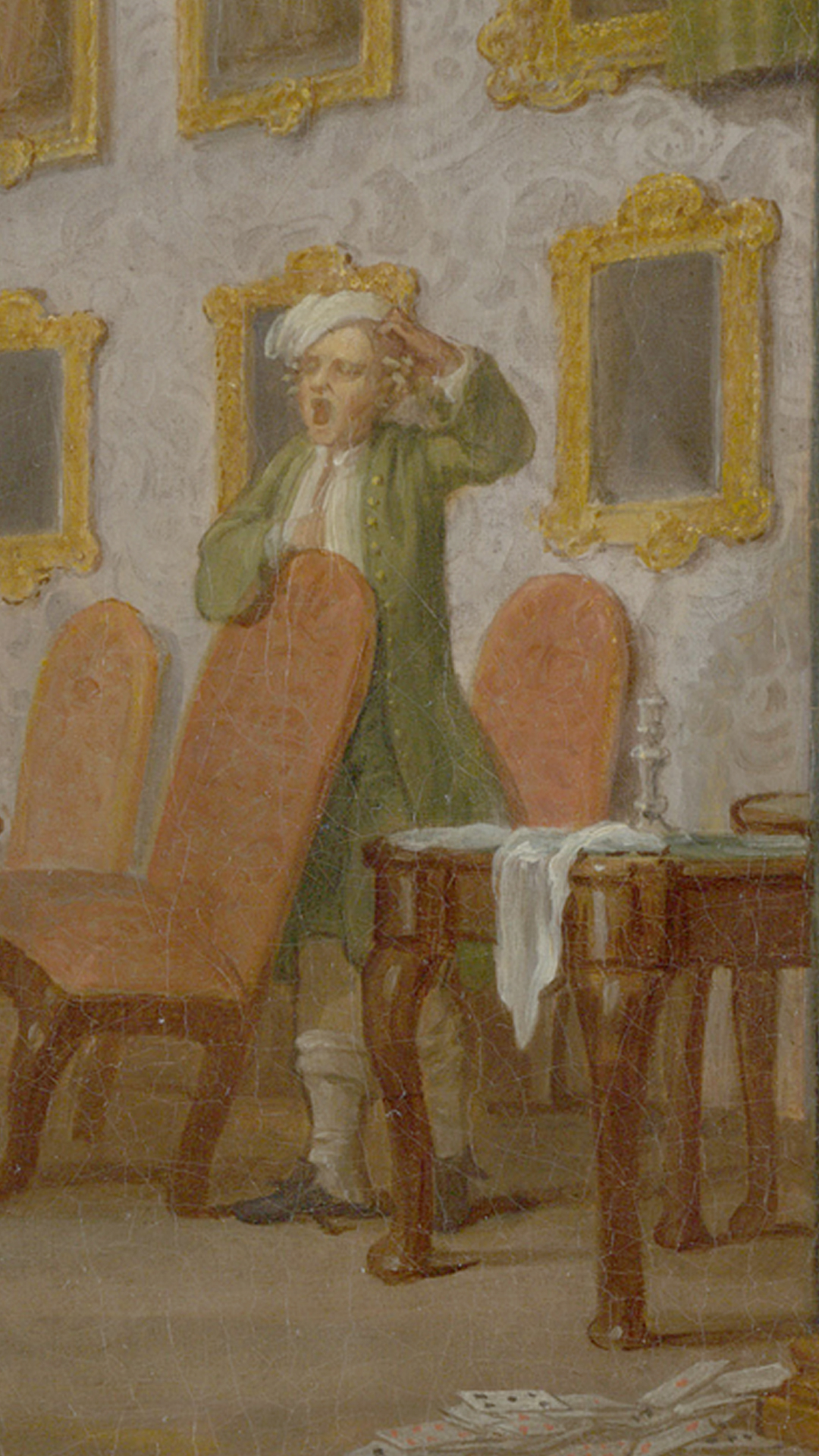The last time we saw this pair, in the first of Hogarth’s Marriage a la Mode series, she was a distraught, pale faced young lady who was being handed over to a vain, snuff sniffing dandy with syphilis. The transaction between their fathers was one of a title for money.

William Hogarth, Marriage a la Mode: Tête-à-tête, 1743, National Gallery, London
Looking at this, we might feel that they’ve actually done rather well. They are in sumptuous surroundings and after all the image is called ‘tête-à-tête’ indicating an intimate conversation, literally ‘head to head’ but look slightly more closely and it’s quite clear that the title is somewhat ironic.

Let’s take the lady first. She looks very self-satisfied or perhaps just satisfied. Her languid yawn with her arms up reveals her open bodice; we can see her corset which is not terribly ladylike but even worse is the way she’s sitting with her legs akimbo and erm, is that a large wet patch in the centre of her skirt? I’m afraid it is! She’s giving her husband the side-eye so if we were going to be generous, we might decide that they’ve had a riotous time together.

There’s a pack of cards discarded on the floor, and the violin cases and the music book suggest not so much music in this instance but sex.
Music was often used as an allusion to sexual activity and just look at the way the violin cases happen to be placed on top of each other, and the way that the violin on top protrudes from the case. Hogarth is keen for us to get the picture!
But looking at him, he’s not so full of himself. Actually I would say that he looks rather dejected, as well as utterly dissipated and hungover. We can see that huge black spot on his neck indicating syphilis so has he perhaps been abstaining? Well, if we read the clues, yes and no.
Remember the dogs in the first image that were chained together but couldn’t even look at each other? It’s man’s best friend that is giving the game away here, too!
What’s the dog sniffing? It’s a bonnet in the Viscount’s pocket and it almost certainly doesn’t belong to the Viscountess. So, it is very much suggested that he’s been out, perhaps to a brothel, whilst she’s stayed at home. However, take a look at the sword on the floor next to him. It’s broken. If a sword is a common phallic symbol, a broken one is a symbol of impotence. So perhaps he abstained through no desire of his own.

There’s another aspect of the work that could lead us to think of impotence; the bust on the mantlepiece has a broken nose. That is sometimes a signifier of impotence but other readings could be that it indicates adultery (throughout the centuries and across cultures, it hasn’t been uncommon for adulterers to have their nose broken in a fight or otherwise – there’s a story of a wronged wife almost chopping off her rival’s nose in 18th century Paris. It was saved by a surgeon), but I would also conject that it’s another sign of syphilis. My summer obsession!!!

So, it becomes obvious that the Viscount has been out and about and his wife has entertained at home. There are two further clues to note on that score; she’s holding up a mirror in quite an unusual way suggesting that she’s perhaps signalling to her lover who made a hasty exit out of the room, and out of the painting, knocking over a chair in the process.
There’s of course another possibility that they’ve run away from the sheer volume of bad taste in what should be a very elegant room. That’s not an actual theory, it’s just allowed me to segue seamlessly back to the mantlepiece where there’s a lot of tat on display in a mishmash of different guises from Buddhas to weird saint type figurines with big hands. They are the sort of second rate antiquities that were palmed off to gullible 18th century collectors who had more money than sense and taste. Even the bust has a man’s face but the hairstyle of a Roman matron. There’s so much available to be picked apart and discussed by the people viewing this image, who, don’t forget were largely the middle classes who would have been delighted I’m sure to have had the opportunity to have ridiculed the aristocracy for their terrible taste and manners.
It’s the clock, however, that is usually reserved for the most ridicule. Elaborate isn’t the word! A cat flanked by fish ‘swimming’ amongst a whole load of foliage with another Buddha at the base holding a couple of candles. Classy! It also reads 12.10 ish by the looks of things which serves as an indication of just how debauched this pair is. It’s clearly not just past midnight, by the way, otherwise the despairing accountant with a stack of bills and receipts surely wouldn’t be there at all. He’s another indication of the couple’s bad behaviour as is the slovenly servant to the rear of the image who still has his nightcap on by the look of things.


The servant draws our attention to this area of the room which has four large paintings of saints, (again, the lovely irony!), several smaller images that can’t be made out and then a work with a curtain partially drawn over it. 18th century audiences would immediately identify this as something saucy or lewd, especially as we can see a well turned ankle and a dainty foot poking out. Infrared technology has revealed that Hogarth actually painted a Madonna and child that he later decided to cover up. Perhaps the joke is partially on us?!
The video of this episode can be viewed here. To view the entire ‘Elevenses with Lynne’ archive, head to the Free Art Videos page.
